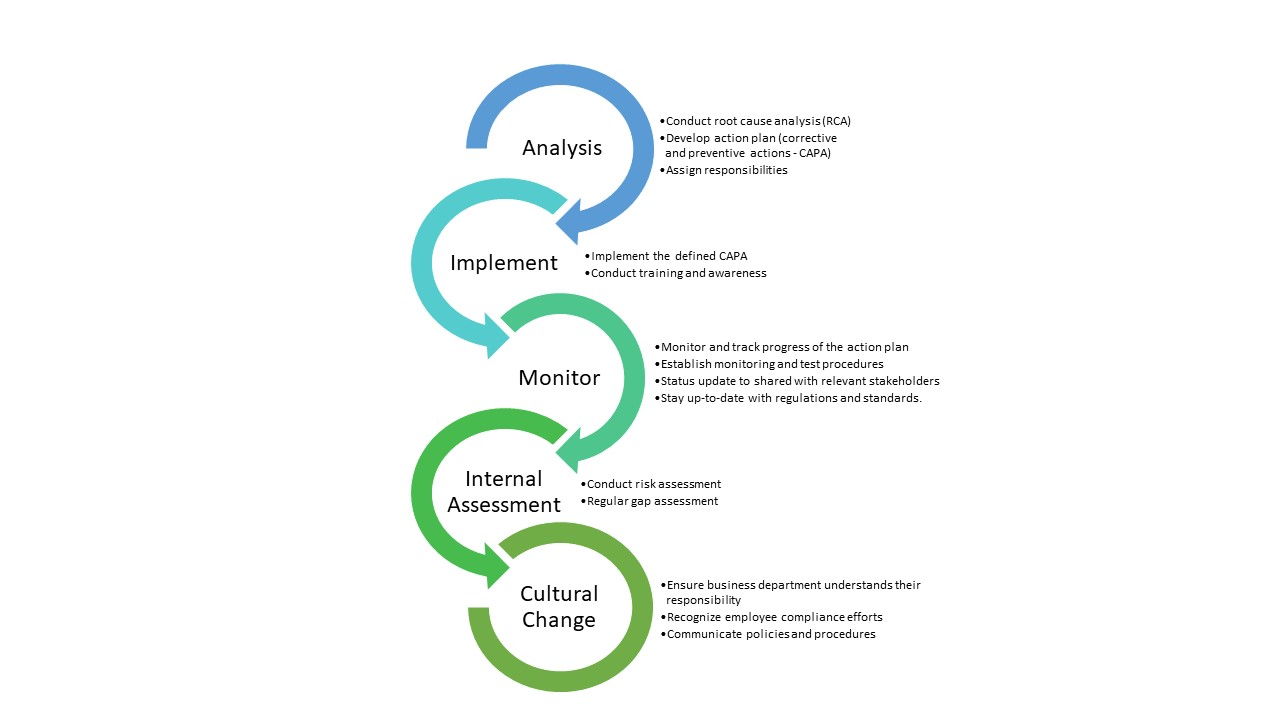The recurrence of audit findings does not necessarily mean that the organization is not making progress toward improving its processes and controls, it just simply means that the organization needs to continuously monitor and review its internal controls and address any identified gaps or potential risks. Organizations must take proactive measures to identify and address any issues identified during an audit to minimize the probability of the recurrence of audit findings.
Why is it so important to prevent recurrence of audit findings? Taking a proactive step will foster ongoing compliance with regulatory requirements and internal policies and procedures. In addition, it improves the overall effectiveness of the organization’s governance, risk, and compliance programs, and promotes a culture of compliance and risk management throughout the organization.
What are the proactive steps to prevent recurrence of audit findings?
Conduct root cause analysis:
The first step is to thoroughly review the past audit findings to identify patterns and trends. This includes understanding the root cause of the audit findings identified, the impact of the issues, and any corrective action that was taken. In performing these activities, it helps to identify areas that require improvement and what steps can be taken to prevent similar issues from occurring in the future. The auditor(s) can also help in identifying repeated findings while documenting the assessment report.
Develop action plans:
Based on the result of the root cause analysis, develop an action plan that outlines the steps needed to address the identified weaknesses and deficiencies with the support and collaboration of relevant stakeholders, these include the process owners, security architect, application developer, and technology/cloud operation teams. The action plan must cover both the corrective and preventive actions and should be specific, measurable, achievable, relevant, and time-bound (SMART).
Assign responsibilities:
Each item in the action plan should be assigned to a specific individual or team with clear responsibilities, timelines, and milestones. This will help to ensure accountability and ownership of the actions. In addition, a reporting mechanism should be established to track the progress of implementation.
Implement corrective and preventive actions:
Once the action plans and responsibilities have been defined, the controls should be implemented. Corrective action is designed to address or remediate the immediate audit findings while preventive control prevents similar issues from reoccurring in the future. These controls include changes to policies, procedures, or processes, updating technology systems, as well as providing training to employees.
Monitor and track progress:
Monitor and track progress toward the implementation of the action plan to ensure they are effective and executed as planned. This can be done through regular status updates, meetings, and reporting. Regular monitoring can help to identify any issues that arise and adjust as necessary before they become more significant problems. Also, status updates should be provided to senior management, leadership, and relevant committees. This ensures that corrective action is being taken and that there is accountability for any identified weaknesses or deficiencies.
Stay up-to-date with regulations and standards:
The GRC team should stay up to date with relevant laws, regulations, standards, and industry best practices to ensure that the organization’s processes and systems remain compliant. This can be done through regular training and education, attending industry events, and networking with other professionals in the field.
Conduct training and awareness programs:
Comprehensive training and awareness programs should be established to help employees understand key compliance and security requirements and their roles and responsibilities related to governance, risk management, and compliance.
Monitor compliance & Continuous improvement:
Implement a continuous compliance monitoring process and encourage a culture of continuous improvement process to ensure that procedures, processes, policies, and controls are regularly reviewed and updated. This can involve soliciting feedback from stakeholders, benchmarking against industry best practices, regular audits, conducting periodic risk assessments, analyzing data, and implementing new technologies and tools to improve efficiency and effectiveness. In situations where potential issues and audit findings are identified, steps can be taken to proactively address them before they result in a finding.
Foster a culture of compliance:
Finally, the GRC team should work to foster a culture of compliance within the organization. This means promoting a strong ethical tone at the top and ensuring that compliance is integrated into all business processes and decision-making. This can be achieved by providing training and education, recognizing employees for their compliance efforts, communicating policies and procedures, and building awareness of the importance of compliance throughout the organization. When business departments understand the importance of compliance and the risks associated with no, they are more likely to follow policies and procedures that help prevent audit findings.



Your point of view caught my eye and was very interesting. Thanks. I have a question for you.
Thanks for sharing. I read many of your blog posts, cool, your blog is very good.